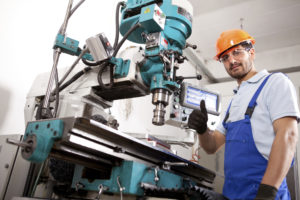PROGRAMS
Not your grandfather’s factory
Next generation industrial careers need high-tech skills
What do you think of when you imagine a shift change at a factory? Unless you work inside one, chances are you think of a whistle, punch-cards and time-clocks, and thousands of workers pouring out of the gates.
 The assembly line of Henry Ford’s day still shapes public perception of manufacturing. But within the industry, vast changes in technology and global trade have transformed the way we design and produce things.
The assembly line of Henry Ford’s day still shapes public perception of manufacturing. But within the industry, vast changes in technology and global trade have transformed the way we design and produce things.
We live in the era of Advanced Manufacturing, where workers with a high level of technical skills are needed to run and maintain complex machines, robots, and computer systems. Far from the negative stereotypes of manufacturing, many of the new jobs in the industry are clean, steady, and offer good pay.
In fact, factory workers are some of the best paid workers in the country, says AJ Jorgenson of the Washington policy think-tank the Manufacturing Institute. “Today’s manufacturing employees earn higher wages and receive more generous benefits than other working Americans.” Jorgenson notes that for 2013, with average wages and benefits totaling $33.93 per hour, “there is almost a 9 percent premium for working in manufacturing.”
Demand for skilled labor is skyrocketing. According to the US Labor Department, Advanced Manufacturing occupations grew by 99.4 percent between 2007 and 2012. And Economic Modeling Specialists International (EMSI) projects that the American manufacturing sector will add 2.5 million new jobs by 2017.
Out with the old, in with the new
As the Baby Boom generation retires, demand for new manufacturing workers will only continue to grow. Currently, Baby Boomers make up about 20 percent of the overall workforce, and an even larger share of industrial jobs. Like many states with long industrial histories, North Carolina faces a shortage of workers in the manufacturing field as the average factory worker is 58 years old.
However, public perception remains a struggle, says Rob Sentz, chief innovation officer at EMSI. Following the massive layoffs in the automobile industry, he says he’s seen parents advising their children against pursuing a career in manufacturing. “Parents still think it’s dirty, dark and dangerous,” Gugger says. “It’s nothing like it used to be. Manufacturing medical devices is lab-coat work.”
“This has contributed to what employers call a ‘skills gap,’ with too few technical workers filling too many jobs. ‘Eighty percent of manufacturers report they cannot find individuals with the skills required,’ the Manufacturing Institute’s Jorgenson notes.”
While the Labor Department reports that manufacturing jobs have declined 35 percent since 1980, the industry has seen a steady resurgence in recent years as companies move operations back to the US – a trend called “reshoring,” or “insourcing.”
“Where the thought becomes the thing”
American manufacturing is leaner, and far more productive, than the factories of old. In fact, the Manufacturing Institute reports that in the two decades up to 2012, manufacturing output increased more than 83 percent.
Against an economic backdrop of the “rise of China,” it’s easy to forget that the US continues to be the largest overall producer of goods and services in the world. If the US manufacturing sector were its own country all on its own, it would still rank as the eighth largest economy in the world – producing more than the entire gross domestic product of India, a well-known export giant!
Manufacturing in America is leaner, but smarter today. This means that the jobs that “return” to the US are different than those that left in the past several decades. They are more technical, and 80 percent require some training, according to a 2012 study by Georgetown University’s Public Policy Institute.
“Today’s manufacturing is about advanced technologies, state-of-the-art facilities, and fast-paced work environments,” states Jorgenson. “It’s where the thought becomes the thing.”
In other words, manufacturing capability has reached the point of “If you can dream it, you can build it.”
Naomi Sheehan
In-demand skills
The Labor Department’s annual Occupational Outlook Handbook describes some of the most sought-after occupations.
Computer Numerical Control (CNC) Programmers
Computer Numerical Control (CNC) programmers develop programs that control machines on the factory floor. They automate production, making the manufacturing process faster, safer, more precise, and more efficient.
Those who excel in this line of work are good with computers and solving problems. The vast majority of CNC programmers, according to a federal survey of the field, hold associate’s degrees or post-secondary certificates.
CNC programmers earned median wages in 2013 of $22.36 an hour, or $46,510 per year. The Labor Department projects much faster than average job growth (22 percent or higher) in this field through 2022.
Computer Aided Drafting and Design (CADD)
Drafters use computers to create technical drawings, help design products, and work with architects, machinists, and engineers to give precise dimensions and instructions for making things. Drafters are often called CADD operators, because the work they do is frequently programmed directly into computer systems that render their designs in three dimensions.
In 2012, drafters made a median pay of $23.86 per hour, or $49,630 per year. Employers generally prefer applicants who have completed an associate’s program.
These workers can work in many fields, from aeronautical to civil drafting, working with architecture firms on construction projects, or with pipefitting operations at oil refineries. Most of a drafter’s workday involves a computer, although some projects require visits to a job site.
Machinists and Tool & Die Makers
Machinists and tool & die makers operate machines by computer controls to produce precision parts and tools. Because of the rapid pace of technological advancements, machinists must be adaptable.
Precision machinists can make anything from simple bolts to tiny screws for orthopedic implants. They produce hydraulic parts, anti-lock brakes, pistons and many more mechanical parts for the auto, airline, and other industries.
The median pay for machinists in 2012 was $19.67 an hour, or $40,910 per year.
Employment for machinists is projected to grow 9 percent over the next decade. According to the Labor Department, while this job growth rate is about average for all occupations, opportunities for young workers entering the field will be “excellent” given the large numbers of retiring Baby Boomers.
SHORT-TERM SCHOOLING LEADS TO CERTIFICATIONS
Earn a certification in Advanced Manufacturing topics through WCC’s Occupational Extension courses. These courses are designed to improve individual efficiencies, upgrade and/or improve present job skills or to prepare for future employment.
Contact the office of Continuing Education Services at 919-739-6900.
CLASSES TO LOOK FOR:
Certified Production Technician (CPT)
CPT is a third party credential awarded by the Manufacturing Skill Standards Council (MSSC). CPT assessments (Safety, Quality Practices & Measurement, Manufacturing Processes & Production and Maintenance Awareness) are offered through the Wayne Business & Industry Center.
Basic Welding I and Basic Welding II
This course is designed to familiarize students with the basics of welding, provide an understanding of the hazards of welding, and teach the use of all safety equipment available. Students will learn why they should use the right type of rod for different kinds of metal. Topics will include gas welding, operation of cutting torch, electric welding, heliarc welding and safety. Training strategies will include lecture and hands-on activities with evaluation based on attendance, class participation and demonstration of skills.
OSHA Industrial Safety 10-Hour and 30-Hour
The OSHA Outreach Training Program provides training for workers and employers on the recognition, avoidance, abatement, and prevention of safety and health hazards in workplaces. The program also provides information regarding workers’ rights, employer responsibilities, and how to file a complaint. Students attend 10-hour or 30-hour classes delivered by an OSHA authorized trainer. Through this training, OSHA helps to ensure that workers are more knowledgeable about workplace hazards and their rights, and contribute to workplace productivity. After successful completion of the class, students will receive an OSHA recognized certificate as well as an OSHA issued 10 Hour or 30 Hour Card corresponding to the classes taken.



